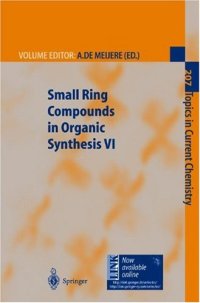
Ebook: Small Ring Compounds in Organic Synthesis VI
- Genre: Chemistry // Organic Chemistry
- Tags: Organic Chemistry
- Series: Topics in Current Chemistry 207
- Year: 2000
- Publisher: Springer-Verlag Berlin Heidelberg
- Edition: 1
- Language: English
- pdf
This current and five previous volumes (Volumes 133, 135, 144, 155, 178) convincingly demonstrate the vast applications of small rings in modern Organic Synthesis. Such applications range from total syntheses of cyclopropyl-group-containing natural products and non-natural biologically active compounds or compounds with other important properties (e.g. liquid crystalline) via syntheses of cyclopropyl analogues of natural and non-natural physiologically active compounds, e.g. peptidomimetics, to the use of cyclopropyl groups as reactive subunits in so-called composite functional groups. This current volume covers a survey of the wide range of biological activities of cyclopropyl-containing compounds, up-to-date comprehensive reviews on the multiple applicabilities of two multifunctional small ring building blocks - methyl-2-chloro-2-cyclopropylidene acetate and bicyclopropylidene - in Organic Synthesis as well as a striking new approach to cyclopentenones from easily accessible 1-ethynylcyclopropanols, which is rather general and favorably complements other cyclopentenone syntheses.
Natural and synthetic cyclopropanes bearing simple functionalities are endowed with a large spectrum of biological properties ranging from enzyme inhibitions to insecticidal, antifungal, herbicidal, antimicrobial, antibiotic, antibacterial, antitumor and antiviral activities.The simple 2-substituted 1-aminocyclopropanecarboxylic acids (ACCs) are currently attracting special attention because of their potential use in conformationally restricted peptides, providing biosynthetic and mechanistic probes. As the immediate biosynthetic precursor of ethylene, the phytohormone that initiates and regulates many aspects of plant growth (germination, inhibition, senescence, fruit ripening, etc.), the parent ACC, structurally related to glycine, is a potent and selective ligand of the glycine modulation site coupled to the N-methyl-D-aspartate (NMDA) receptor, one of the four different receptors that mediate the action of the excitatory amino acids (EAA) in the brain transmitter systems; thus, such amino acids have also been proven to be useful in neurochemical studies. The mechanisms responsible for the diverse specific biological activities of compounds containing three-membered carbocyclic moieties are also being discussed.